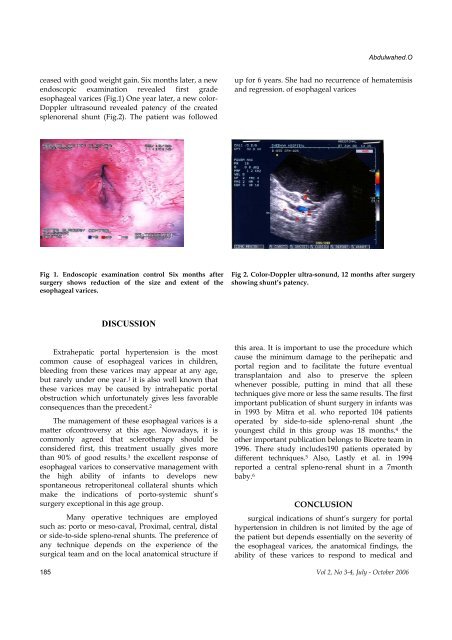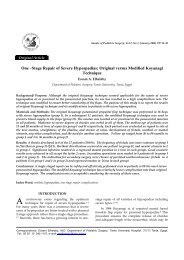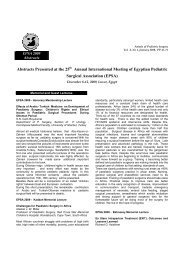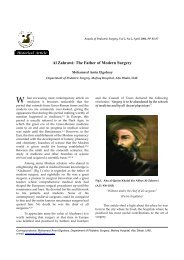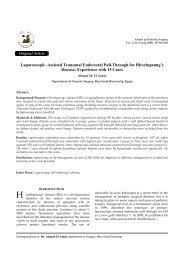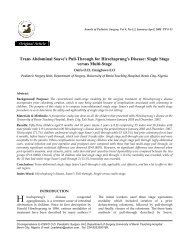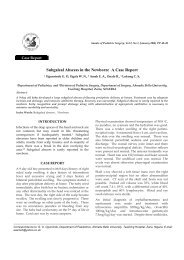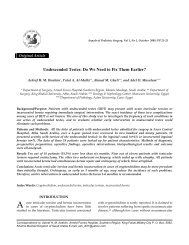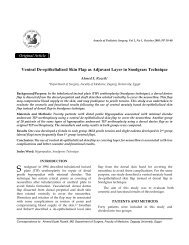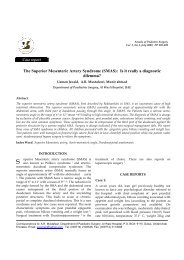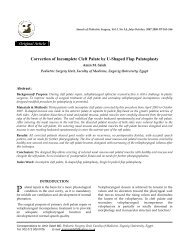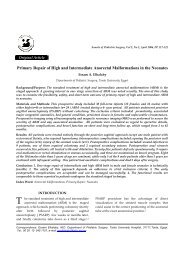Side-To-Side Spleno-Renal Shunt Surgery for Portal Hypertension ...
Side-To-Side Spleno-Renal Shunt Surgery for Portal Hypertension ...
Side-To-Side Spleno-Renal Shunt Surgery for Portal Hypertension ...
Create successful ePaper yourself
Turn your PDF publications into a flip-book with our unique Google optimized e-Paper software.
Abdulwahed.Oceased with good weight gain. Six months later, a newendoscopic examination revealed first gradeesophageal varices (Fig.1) One year later, a new color-Doppler ultrasound revealed patency of the createdsplenorenal shunt (Fig.2). The patient was followedup <strong>for</strong> 6 years. She had no recurrence of hematemisisand regression. of esophageal varicesFig 1. Endoscopic examination control Six months aftersurgery shows reduction of the size and extent of theesophageal varices.Fig 2. Color-Doppler ultra-sonund, 12 months after surgeryshowing shunt’s patency.DISCUSSIONExtrahepatic portal hypertension is the mostcommon cause of esophageal varices in children,bleeding from these varices may appear at any age,but rarely under one year. 1 it is also well known thatthese varices may be caused by intrahepatic portalobstruction which un<strong>for</strong>tunately gives less favorableconsequences than the precedent. 2The management of these esophageal varices is amatter ofcontroversy at this age. Nowadays, it iscommonly agreed that sclerotherapy should beconsidered first, this treatment usually gives morethan 90% of good results. 3 the excellent response ofesophageal varices to conservative management withthe high ability of infants to develops newspontaneous retroperitoneal collateral shunts whichmake the indications of porto-systemic shunt’ssurgery exceptional in this age group.Many operative techniques are employedsuch as: porto or meso-caval, Proximal, central, distalor side-to-side spleno-renal shunts. The preference ofany technique depends on the experience of thesurgical team and on the local anatomical structure ifthis area. It is important to use the procedure whichcause the minimum damage to the perihepatic andportal region and to facilitate the future eventualtransplantaion and also to preserve the spleenwhenever possible, putting in mind that all thesetechniques give more or less the same results. The firstimportant publication of shunt surgery in infants wasin 1993 by Mitra et al. who reported 104 patientsoperated by side-to-side spleno-renal shunt ,theyoungest child in this group was 18 months. 4 theother important publication belongs to Bicetre team in1996. There study includes190 patients operated bydifferent techniques. 5 Also, Lastly et al. in 1994reported a central spleno-renal shunt in a 7monthbaby. 6CONCLUSIONsurgical indications of shunt’s surgery <strong>for</strong> portalhypertension in children is not limited by the age ofthe patient but depends essentially on the severity ofthe esophageal varices, the anatomical findings, theability of these varices to respond to medical and185 Vol 2, No 3-4, July - October 2006


